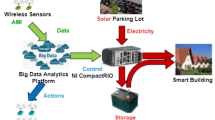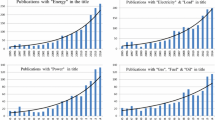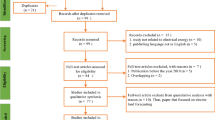Abstract
Due to deregulation of electricity industry, accurate load forecasting and predicting the future electricity demand play an important role in the regional and national power system strategy management. Electricity load forecasting is a challenging task because electric load has complex and nonlinear relationships with several factors. In this paper, two hybrid models are developed for short-term load forecasting (STLF). These models use “ant colony optimization (ACO)” and “combination of genetic algorithm (GA) and ACO (GA-ACO)” for feature selection and multi-layer perceptron (MLP) for hourly load prediction. Weather and climatic conditions, month, season, day of the week, and time of the day are considered as load-influencing factors in this study. Using load time-series of a regional power system, the performance of ACO + MLP and GA-ACO + MLP hybrid models is compared with principal component analysis (PCA) + MLP hybrid model and also with the case of no-feature selection (NFS) when using MLP and radial basis function (RBF) neural models. Experimental results and the performance comparison with similar recent researches in this field show that the proposed GA-ACO + MLP hybrid model performs better in load prediction of 24-h ahead in terms of mean absolute percentage error (MAPE).



Similar content being viewed by others
References
Gross G, Galiana F (1987) Short term load forecasting. Proc IEEE 75:1558–1573
Sadownik R, Barbosa E (1999) Short-term forecasting of industrial electricity consumption in Brazil. Int J Forecast 18:215–224
Afshin M, Sadeghian A (2007) PCA-based least squares support vector machines in week-ahead load forecasting. In: Proceedings of IEEE industrial and commercial power systems technical conference, pp 1–6
Kothari DP, Nagrath IJ (2003) Modern power system analysis, 3rd edn. Tata McGraw Hill, New Delhi
Feinberg EA, Genethliou D (2005) Load forecasting. In: Chow JH, Wu FF, Momoh JJ (eds) Applied mathematics for restructured electric power systems: optimization, control and computational intelligence, power electronics and power systems. Springer, US, pp 269–285
Gonzalez-Romera E, Jaramillo-Moran MA, Carmona-Fernandez D (2006) Monthly electric energy demand forecasting based on trend extraction. IEEE Trans Power Syst 21:1946–1953
Kyriakides E, Polycarpou M (2007) Short term electric load forecasting: a tutorial. In: Chen K, Wang L (eds) Trends in neural computation, studies in computational intelligence. Springer, Berlin, pp 391–418
Hahn H, Meyer-Nieberg S, Pickel S (2009) Electric load forecasting methods: tools for decision making. Eur J Oper Res 199:902–907
Amjady N (2001) Short-term hourly load forecasting using time-series modeling with peak load estimation capability. IEEE Trans Power Syst 16:498–505
Huang S-J, Shih K-R (2003) Short-term load forecasting via ARMA model identification including non-Gaussian process considerations. IEEE Trans Power Syst 18:673–679
Al-Hamadi HM, Soliman SA (2004) Short-term electric load forecasting based on Kalman filtering algorithm with moving window weather and load model. Electr Power Syst Res 68:47–59
Gao J, Sun H-B, Tang G-Q (2001) Application of optimal combined forecasting based on fuzzy synthetic evaluation on power load forecast. J Syst Eng 16:106–110
Kodogiannis VS, Anagnostakis EM (2002) Soft computing based techniques for short-term load forecasting. Fuzzy Sets Syst 128:413–426
Al-Kandari AM, Soliman SA, El-Hawary ME (2004) Fuzzy short-term electric load forecasting. Int J Electr Power Energy Syst 26:111–122
Kim KH, Park JK, Hwang KJ, Kim SH (1995) Implementation of hybrid short-term load forecasting system using artificial neural networks and fuzzy expert-systems. IEEE Trans Power Syst 10:1534–1539
Satish B, Swarup KS, Srinivas S, Rao AH (2004) Effect of temperature on short-term load forecasting using an integrated ANN. Electr Power Syst Res 72:95–101
He W (2008) Forecasting electricity load with optimized local learning models. Int J Electr Power Energy Syst 30:603–608
Alves da Silva A, Ferreira VH, Velasquez MG (2008) Input space to neural network based load forecasters. Int J Forecast 24:616–629
Xiao Z, Ye S-J, Zhang B, Sun C-X (2009) BP neural network with rough set for short term load forecasting. Expert Syst Appl 36:273–279
Niu D, Wang Y, Dash Wu D (2010) Power load forecasting using support vector machine and ant colony optimization. Expert Syst Appl 37:2531–2539
Christianse WR (1971) Short term load forecasting using general exponentials smoothing. IEEE Trans Power Apparatus Syst 90:900–911
Park JH, Park YM, Lee KY (1991) Composite modeling for adaptive short-term load forecasting. IEEE Trans Power Syst 6:450–457
Gelb A (1974) Applied optimal estimation. MIT Press, Massachusetts
Brown RG (1983) Introduction to random signal analysis and Kalman filtering. Wiley, New York
Moghram I, Rahman S (1989) Analysis and evaluation of five short-term load forecasting techniques. IEEE Trans Power Syst 4:1484–1491
Douglas AP, Breipohl AM, Lee FN, Adapa R (1998) The impact of temperature forecast uncertainty on Bayesian load forecasting. IEEE Trans Power Syst 13:1507–1513
Carpinteiro OAS, Reis AJR, da Silva APA (2004) A hierarchical neural model in short-term load forecasting. Appl Soft Comput 4:405–412
Cai Y, Wang J-Z, Tang Y, Yang Y-C (2011) An efficient approach for electric load forecasting using distributed ART (adaptive resonance theory) & HS-ARTMAP (Hyper-spherical ARTMAP network) neural network. Energy 36:1340–1350
Liao G-C, Tsao T-P (2004) Application of fuzzy neural networks and artificial intelligence for load forecasting. Electr Power Syst Res 70:237–244
Yao SJ, Song YH, Zhang LZ, Cheng XY (2000) Wavelet transform and neural networks for short-term electrical load forecasting. Energy Convers Manag 41:1975–1988
Zhang B-L, Dong Z-Y (2001) An adaptive neural-wavelet model for short-term load forecasting. Electr Power Syst Res 59:121–129
Pai P-F, Hong W-C (2005) Forecasting regional electricity load based on recurrent support vector machines with genetic algorithms. Electr Power Syst Res 74:417–425
Pai P-F, Hong W-C (2005) Support vector machines with simulated annealing algorithms in electricity load forecasting. Energy Convers Manag 46:2669–2688
Hong W-C (2009) Hybrid evolutionary algorithms in a SVR-based electric load forecasting model. Electr Power Energy Syst 31:409–417
Dash M, Liu H (1997) Feature selection for classification. Intell Data Anal 1:131–156
Wang Z, Cao Y (2006) Short-term load forecasting based on mutual information and artificial neural networks. Lecture Notes Comput Sci 3972:1246–1251
Siwek K, Osowski S (2010) Neural network ensemble for 24-hour load pattern prediction in power systems. Stud Comput Intell 302:151–169
Hippert HS, Taylor JW (2010) An evaluation of Bayesian techniques for controlling model complexity and selecting inputs in a neural network for short-term load forecasting. Neural Netw 23:386–395
Niu D, Gu Z, Zhang Y (2009) An AFSA-TSGM based wavelet neural network for power load forecasting. Lecture Notes Comput Sci 5553:1034–1043
Niu D, Kou B, Zhang Y, Gu Z (2009) A short-term load forecasting model based on LS-SVM optimized by dynamic inertia weight particle swarm optimization algorithm. Lecture Notes Comput Sci 5552:242–250
Ghanbari A, Hadavandi E, Abbasian-Naghneh S (2010) An intelligent ACO-SA approach for short term electricity load prediction. Lecture Notes Comput Sci 6216:623–633
Kelo SM, Dudul SV (2011) Short-term Maharashtra state electrical power load prediction with special emphasis on seasonal changes using a novel focused time lagged recurrent neural network based on time delay neural network model. Expert Syst Appl 38:1554–1564
Maniezzo V, Colomi A (1999) The ant system applied to the quadratic assignment problem. Knowl Data Eng 11:769–778
Goldberg DE (1989) Genetic algorithms in search, optimization, and machine learning. Addison Wesley, New York
Srinivas M, Patnik LM (1994) Genetic algorithms: a survey. IEEE Computer Society Press, Los Alamitos
Amjady N, Keynia F (2009) Short-term load forecasting of power systems by combination of wavelet transform and neuro-evolutionary algorithm. Energy 34:46–57
Kohavi R, John JH (1997) Wrappers for feature subset selection. Artif Intell 97:273–324
Fodor IK (2002) A survey of dimension reduction techniques, Technical Report UCRL-ID-148494, Lawrence Livermore National Laboratory, US Department of Energy
Rashidy Kanan H, Faez K (2008) An improved feature selection method based on ant colony optimization (ACO) evaluated on face recognition system. Appl Math Comput 205:716–725
Al-Ani A (2005) Feature subset selection using ant colony optimization. Int J Comput Intell 2:53–58
Nemati S, Basiri ME, Ghasem-Aghaee N, Hosseinzadeh Aghdam M (2009) A novel ACO–GA hybrid algorithm for feature selection in protein function prediction. Expert Syst Appl 36:12086–12094
Mishra S, Patra SK (2008) Short term load forecasting using a neural network trained by a hybrid artificial immune system. In: Proceedings of IEEE third international conference on industrial and information systems, pp 1–5
Wang J, Liu Z, Lu P (2008) Electricity load forecasting based on adaptive quantum-behaved particle swarm optimization and support vector machines on global level. In: Proceedings of international symposium on computational intelligence and design, pp 233–236
Author information
Authors and Affiliations
Corresponding author
Rights and permissions
About this article
Cite this article
Sheikhan, M., Mohammadi, N. Neural-based electricity load forecasting using hybrid of GA and ACO for feature selection. Neural Comput & Applic 21, 1961–1970 (2012). https://doi.org/10.1007/s00521-011-0599-1
Received:
Accepted:
Published:
Issue Date:
DOI: https://doi.org/10.1007/s00521-011-0599-1




